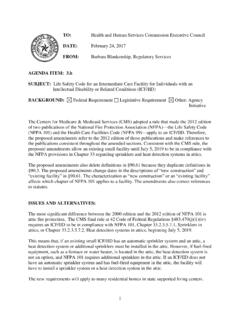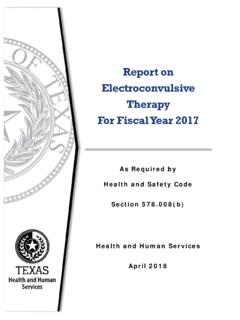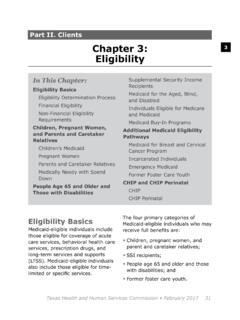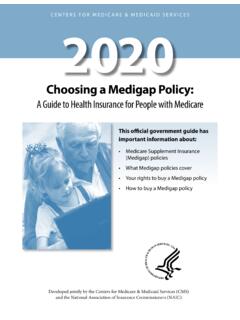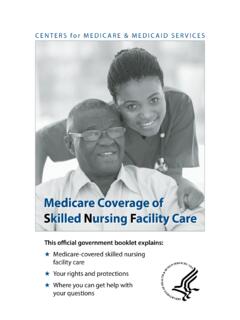Transcription of Chapter 3: Eligibility - Texas Health and Human Services
1 Texas Health and Human Services Commission February 2017 31 Chapter 3: Eligibility33 Part II. ClientsChapter 3: EligibilityEligibility BasicsMedicaid-eligible individuals include those eligible for coverage of acute care Services , behavioral Health care Services , prescription drugs, and long -term Services and supports (LTSS). medicaid -eligible individuals also include those eligible for time-limited or specific Services . The four primary categories of medicaid -eligible individuals who may receive full benefits are: Children, pregnant women, and parent and caretaker relatives; SSI recipients; People age 65 and older and those with disabilities; and Former foster care This Chapter : Eligibility BasicsEligibility Determination ProcessFinancial EligibilityNon-Financial Eligibility RequirementsChildren, Pregnant Women, and Parents and Caretaker RelativesChildren s MedicaidPregnant WomenParents and Caretaker RelativesMedically Needy with Spend DownPeople Age 65 and Older and Those with DisabilitiesSupplemental Security Income RecipientsMedicaid for the Aged, Blind, and DisabledIndividuals Eligible for Medicare and MedicaidMedicaid Buy-In ProgramsAdditional medicaid Eligibility PathwaysMedicaid for Breast and Cervical Cancer ProgramIncarcerated IndividualsEmergency MedicaidFormer Foster Care YouthCHIP and CHIP PerinatalCHIPCHIP Perinatal32 Texas medicaid and CHIP in Perspective 11th EditionPart II.
2 Clients33 Other individuals who may be eligible for limited benefits or specific Services include: Medicare beneficiaries Based on income level and age, certain Medicare beneficiaries qualify for partial medicaid benefits. Non-citizens Includes legal permanent residents or undocumented individuals who are not eligible for medicaid based on their status who may receive emergency Services . Individuals receive medicaid coverage limited to treatment of an emergent who do not qualify for medicaid because of income may be eligible for Determination ProcessHealth and Human Services Commission (HHSC) Eligibility staff use the Texas Integrated Eligibility Redesign System, an integrated system used to determine Eligibility for medicaid , the Children s Health Insurance Program (CHIP), Supplemental Nutrition Assistance Program (SNAP), and Temporary Assistance for Needy Families (TANF). HHSC offers individuals needing assistance access to Eligibility Services through multiple channels, including: A self-service website ( ); A smartphone application; A network of local Eligibility offices and community-based organizations; and The 2-1-1 phone smartphone application is intended to complement, not replace, Its features focus on case management functions easily completed on a smartphone.
3 On the smartphone application, individuals can: View case details; Manage account settings; Upload verifications and forms; View alerts; Report changes on the account; and Find a local addition, to help individuals apply for benefits online, HHSC has a statewide network of community-based organizations participating in the Community Partner Program. Community partners include non-profit, faith-based, local, and statewide community groups. Community partners may participate in the program as self-service or assistance sites. Self-service sites provide access to computers with an internet connection, while assistance sites provide computer access as Texas Health and Human Services Commission February 2017 33 Chapter 3: Eligibility33well as trained and certified staff and volunteers to help clients apply and manage their cases EligibilityFor most individuals, federal law requires states to determine financial Eligibility for medicaid and CHIP based on the Modified Adjusted Gross Income (MAGI) methodology and applies a five percentage point income disregard.
4 The MAGI methodology uses federal income tax rules for determining income and household composition and applies to the children, pregnant women, and parents and caretaker relatives medicaid Eligibility groups. There is also not an asset test when determining medicaid and CHIP Eligibility under the MAGI following groups do not use the MAGI methodology when determining Eligibility : Emergency medicaid ; Foster care children; Medically needy; Individuals receiving SSI; and medicaid programs for people age 65 and over and those with disabilities. In addition, these groups do have an asset test and allow for income disregards. Income DisregardsIn certain situations, some portion of a person s income and resources may be disregarded when calculating Eligibility for medicaid programs not subject to the MAGI methodology. A portion of a family s income and resources may be disregarded due to work expenses, cost of living increases, or when a child (under age 18) becomes a full-time resident of a nursing facility (NF) or an intermediate care facility for individuals with an intellectual disability or related condition (ICF/IID).
5 In some cases, including for some people enrolled in medicaid home and community-based Services (HCBS) waiver programs, all of the parents or spouse s income and resources are disregarded, and only the person s own income and resources are counted in deciding medicaid Eligibility . Persons applying for programs not subject to the MAGI methodology, including programs for people age 65 and older, those with disabilities, and SSI recipients, may receive one or more of the following income disregards: $20 disregard The first $20 of any kind of income is excluded. Earned income The first $65 of earned income plus half of the 34 Texas medicaid and CHIP in Perspective 11th EditionPart II. Clients33remainder of earned income is disregarded. Certain increases in Social Security benefits for persons denied SSI. Veteran s Administration Aid and Attendance Allowances and Housebound Allowances. Persons applying for medicaid programs subject to the MAGI methodology receive a standard income disregard equivalent to five percentage points of the FPL (in 2016, an $ disregard for a family of 3).
6 Figure shows Texas medicaid s maximum monthly income limits by Eligibility category, while Table and Table outline Texas medicaid caseload sizes by Eligibility category for full and non-full medicaid beneficiaries, : medicaid Eligibility in Texas , Maximum Monthly Income Limits, March 2016$230$275$733$2,199$2,235$2,420$3,327 $0$500$1,000$1,500$2,000$2,500$3,000$3,5 00 PregnantWomen and Newborns Up To Age 1, 198% of FPLC hildren Ages 1-5, 144% of FPLC hildren Ages 6-18, 133%of FPLLong Term Services and Supports, 222% of FPL*SSI for Aged and Disabled, 74% of FPL*Medically Needy, 16% of FPL**Parents/Caretaker Relatives, 14% of FPL** Family of one adult ** Family of three ** Family of three (one-parent household)Note 1: Countable Income is gross income adjusted for allowable deductions, expenses, and 2: SSI does not certify families, regardless of size; it certifies individuals and Health and Human Services Commission February 2017 35 Chapter 3: Eligibility33 Table.
7 Full Beneficiary Caseload by Eligibility Category, SFY 2015 General Category for Full medicaid Beneficiaries n = 4,587,119 Eligibility CategoryFPL% or Income LimitPercent of Full medicaid BeneficiariesFamilies and Children (Non-Disability-Related)Children less than 1Up to 198%7%Children 1-5Up to 144%22%Children 6-18Up to 133%43%Pregnant WomenUp to 198%3%Parents and Caretaker Relatives*Up to $230/month4%Medically Needy with Spend Down**Up to $275/monthLess than 1%Former Foster Care ChildrenNo limitLess than 1% medicaid for Transitioning Foster Care Youth413%Less than 1% medicaid for Breast and Cervical Cancer ProgramWomen with an eligible breast or cervical cancer diagnosis receive full medicaid benefits during treatmentNot tested by HHSCLess than 1%Aged, Medicare, and Disability-Related (Including SSI Cash Assistance)SSI (Disability-Related) - AdultNo more than $733/month6%SSI (Disability-Related) - Under 21No more than $733/month4%Aged and Medicare-RelatedNo more than $733/month9%Presumptive Eligibility ProgramsChildren, Parents and Caretaker Relatives, Former Foster Care Children, Breast and Cervical Cancer determined presumptively eligible for full medicaid coverageVaries by corresponding programLess than 1%*Family of three (one-parent household)**Family of three 36 Texas medicaid and CHIP in Perspective 11th EditionPart II.
8 Clients33 Table : Non-Full Beneficiary Caseload by Eligibility Category, SFY 2015 General Category for Non-Full medicaid Beneficiaries n = 362,955 Eligibility CategoryFPL% or Income LimitPercent of Non-Full medicaid BeneficiariesMedicare-RelatedQualified Medicare Beneficiaries (QMB), Specified Low-Income Medicare Beneficiaries (SLMB), and Qualified Individuals (QI)Varies by program69%Emergency Care OnlyCertain qualified immigrants and undocumented immigrants receive medicaid for the expenses incurred for the actual days spent in the hospital based on an emergent conditionVaries by age (based on Eligibility categories in Table )3%Pregnant Women - PresumptiveWomen determined presumptively eligible for Pregnant Women medicaid for limited medicaid coverage198%Less than 1%Healthy Texas Women ProgramNon-pregnant women ages 15 - 44 Up to 200%29%Non-Financial Eligibility RequirementsIn order to qualify for medicaid Services , individuals must also meet non-financial Eligibility criteria such as: Texas residency Reside and intend to remain in Texas Age Be within the age limits for the specific medicaid program Social security status All applicants must provide a Social Security number (SSN) or apply for one Citizenship or alien status Meet citizenship or alien status program requirementsAll citizens and nationals are entitled to apply for and receive medicaid if they provide documentation of their citizenship and identity and meet all other Eligibility requirements.
9 Qualified aliens and non-citizens include: Legal Permanent Residents (LPRs): Any person not a citizen of the who is residing in the under legally recognized and lawfully recorded permanent residence Texas Health and Human Services Commission February 2017 37 Chapter 3: Eligibility33as an immigrant. Also known as Permanent Resident Alien, Resident Alien Permit Holder, and Green Card Holder (includes Amerasians); Asylees; Refugees; Aliens paroled into the for at least one year; Aliens whose deportations are being withheld; Aliens granted conditional entry, prior to April 1, 1980; Battered alien spouses, battered alien children, alien parents of battered children, and alien children of battered parents who meet certain federal law criteria; Cuban/Haitian entrants; and Victims of Human to Seven YearsCertain aliens are immediately eligible for full medicaid , if all other Eligibility requirements are met, but are limited to seven years of medicaid Eligibility from the date an individual obtains qualified alien status, which may be the date of entry: Refugees (including Afghan and Iraqi special immigrants); Asylees; Aliens whose deportations are being withheld; Cuban/Haitian entrants.
10 And Waiting Period or Limited Eligibility PeriodQualified aliens who are immediately eligible for full medicaid , if all other Eligibility requirements are met, and have no time limited period of medicaid Eligibility are as follows: Veterans, active duty members of the armed forces, including their spouses and dependent children; Certain American Indians born outside the ; Aliens receiving medicaid based on receiving SSI cash benefits; and LPRs admitted prior to August 22, 1996, credited with 40 qualifying quarters of social security of Human TraffickingVictims of Human trafficking who the Department of Health and Human Services determines are certified and eligible are immediately eligible for full medicaid . Five Year Wait PeriodLPRs admitted to the on or after August 22, 1996, who are not covered under an alien classification subject to the seven year limit, or who have no time limit for full medicaid , are not eligible for full medicaid for five years from the date of entry to the LPRs admitted to the before August 22, 1996, who do not obtain 38 Texas medicaid and CHIP in Perspective 11th EditionPart II.




